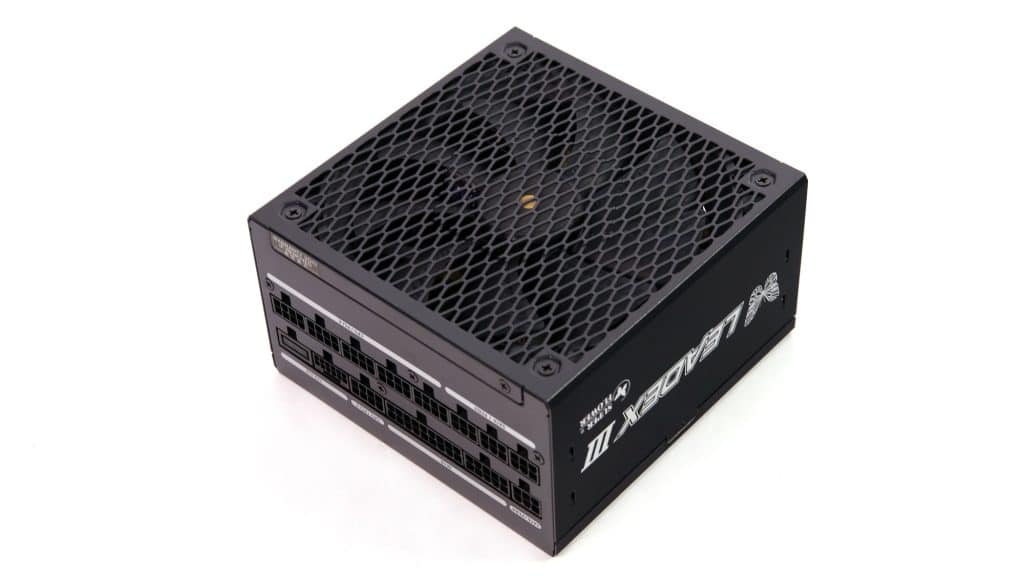Epilogue
The Super Flower Leadex III 1300W is offered at a very good price; it is powerful, can deliver up to 2600W of power with its rails remaining inside the ATX spec’s requirements, its ripple suppression and load regulation are good, and has high enough average efficiency. The significant downsides are the failure of the 5VSB rail during OCP evaluation, which I believe is an easy fix, the inefficient 5VSB rail, which reminds me of older PSU designs, the high inrush currents, the increased vampire power and the not-that-high PF readings at 230V. As you can see from the downsides list, most have to do with the 5VSB rail, so it is time for SF to use a better circuit in this PSU, allowing it to show its full potential.
Although the average noise output exceeds 30 dBA, compared to other similar-spec units, the Leadex III 1300W is not that noisy. Only the way more expensive Cooler Master X Silent Max Platinum and Seasonic Prime TX-1300 are far away, with the XPG Cybercore II 1300 Platinum being slightly below 30 dBA. You cannot have it all: compact dimensions, low price, and low noise output. I prefer any day of the week a normal-dimension PSU with a large PCB and fan to allow for good cooling at low speeds over a small one with increased noise output. Users needing a 1300W unit will most likely not install them in tiny chassis.
Before investing in a new power supply, read my Best ATX v3.x PSUs article to check all alternative PSU offerings. You help me a lot by using my affiliate links, which don’t increase the product’s price. I get a commission from Amazon every time you do it, which can make a difference for me, especially now that I am on my own, working exclusively for my media and not for someone else.
- Highly affordable at $160 (for its specs)
- Delivered full power at 46°C
- Decent overall performance
- High enough average efficiency (115V: Cybenetics Platinum)
- Tight load regulation on the +12V and minor rails
- Good enough ripple suppression
- Good transient response (normal loads) at +12V
- Extended hold-up time
- Higher than 70% efficiency with a 2% load
- Alternative Low Power Mode (ALPM) compatible
- 4x PCIe on dedicated cables and 1x 12+4-pin PCIe connectors
- 5VSB rail needs a better regulation circuit ASAP
- 5VSB OCP triggering point needs to be properly set
- 12V rail’s performance in ATX v3.x transient response tests needs improvement
- Mediocre transient response on the minor rails
- Increased vampire power consumption
- High inrush currents
- PF readings need to get higher (at 230V mostly)
- Lower than 150mm distance between the SATA connectors





You can blame dell apfc psu from 2012. But in reality they were made good psu. Problem is just newly concept idea used that not still fully finished 2025. APFC psu prone to failure due to incomplete technology cooling or efficiency eventualy they lived short than passive psu. Because of that they runs on lower loads called hybrid or passive until 60% loads. When it hits 80% kicks in active power factor correction activated even cooling might not help if it runs 100% loads. However apfc is becoming trend is might be good at sound but passive is budget option. Avoid glitches or issues just put good ups that will be enough handling most problems and your computer will be longer to live
I have two brand new Leadex III PSUs that are failing the Power Good test on a Thermaltake Dr. Power III. The tester is passing all of my other PSUs (Leadex VII XG, Seasonic Focus, Corsair RMx Shift). Is this just really bad luck, or is there some kind of compatibility issue with the tester?
don’t trust so much these inexpensive tools. Don’t get me wrong, they are great for fast readings and to get an idea if something is way wrong, but for things like timings etc. they are so so.
I just installed the 850W version and the fan behavior is a bit confusing to me. In all three modes, the fan is equally loud — it feels like it’s running at around 1500 to 1800 RPM, at least based on the noise level and airflow. In continuous mode, it’s just as loud as in the other modes, the only difference being the temperature trigger points. Even when I set it to the highest trigger threshold, the fan still kicks in every few minutes — and I’m not even drawing 400W. Is this normal?
I’m having the exact same problem with mine. Sent it to warranty but it checked out ok, now stuck with this loud fan. Does yours also smell like a factory, did it clear out? Mine is rancid after even after 1 week.
What differences Leadex III and Leadex VII series have?
different platform
Do you think the 1000w version of this PSU is good? There’s no reviews on it
Should I buy Super Flower Leadex III 1300W ATX v3.1 or Cooler Master MWE gold v2 1250w to be on safe site about 2vsb rail?
SF told me that they will fix the 5VSB OCP.
thank you for replying! what about NZXT c1000 atx3.1 or Corsair RM1000e? NZXT c1000 atx3.1 is just few dollars more at my country
I got this PSU but I think mine is dead. Tried doing a BIOS flashback with just the motherboard and cpu power plugged in and nothing happened (yes the psu was switched on). I then did the paperclip test and the fan didnt spin but im not sure if it normally spins at startup. Does anyone know? I tried both with ECO on and ECO off.
with ECO off the PSU’s fan should start.
Thanks for your review. Any thoughts on what you’d pick between the 1000W version of this and the new (ATX 3.1) RM1000x that you reviewed in September?
I am also looking at the Leadex VII XP Platinum that you recommend in your guide. But I think this review is the first time anyone has looked at one of the new ATX 3.1 Leadex III models.
The difference in Wattage us huge between these two, 300W. If you need more power, the Leadex III.
Aris do you have any info for Asrock PSU ?
Yes. FSP and HEC OEMs.